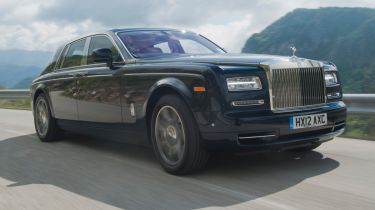Rolls-Royce Phantom II
Updates to the Rolls-Royce Phantom aim to make the best car in the world better. Do they succeed?

For style and magic-carpet ride, nothing comes close to a Phantom. The new box has added a degree of economy and performance, although there are still some bugs. It’s probably still the world’s finest car – from the rear seats, if not from behind the wheel.
While they don’t revamp Rolls-Royces as frequently as, say, Renaults, the almost 10-year life of the Phantom is still something of a landmark. Yet longevity is exactly what owners requested. “Our customers don’t want a new car coming to market too often,” Rolls-Royce told us.
So will they be upset by this updated Phantom? It would be difficult to think so; put old and new together and you’d struggle to spot the differences. The main changes are a new ZF eight-speed auto box and rear differential, revised sat-nav, a 360-degree-view camera system, Harman Kardon stereo and some of the most subtle coachwork changes ever seen on a new model.
Under the body there is some strengthening for the aluminium spaceframe chassis, but even the most noticeable change – the adoption of rectangular LED headlamps – is pretty subtle.
So is it much ado about nothing? Not really, as the old six-speed transmission was an Achilles’ heel; it failed to make the most of the 6.75-litre V12 and could be a bit jerky, too.
Used - available now

2020 Peugeot
3008
38,095 milesManualDiesel1.5L
Cash £12,299
2025 Toyota
Yaris Hybrid
8,232 milesAutomaticPetrol1.5L
Cash £15,750
2023 Honda
Jazz
13,611 milesAutomaticPetrol1.5L
Cash £17,995
2023 Tesla
New Model Y
16,397 milesAutomaticElectric
Cash £29,750The new transmission gives a 10 per cent efficiency boost and is generally smoother, but it’s not all good news. Standing-start acceleration is limited, as the software protects the box from the onslaught of torque and the transmission sometimes doesn’t know which ratio to select, particularly when coming out of corners on a constant throttle.
On the whole, however, the new box gives the quantity of gears the Phantom requires to retain its position as ‘the finest car in the world’.
Not that owners of this near-six-metre-long, 2.6-tonne monster would necessarily want to drive it themselves. Dynamically it’s very good, and although the ride is soft, body roll is well controlled and the steering, while slow, is accurate and responsive.
As you might expect, there’s an eerie silence to the cabin, but this gargantuan saloon, with its rear-hinged back doors and double-floor architecture, is really all about riding in the back.
The improvements inside – especially that 360-degree camera and the programmable sat-nav – make the Rolls easier to live with, although it’s still a handful.
The mild redesign of the dashboard, with its 8.8-inch sat-nav screen, has accompanied the sad loss of the retro design and Bakelite buttons. But overall, the updates should attract new customers without upsetting existing ones.







